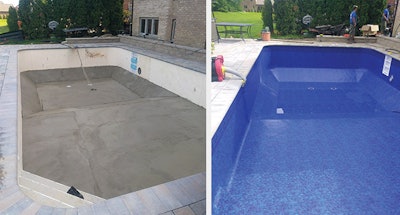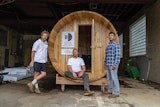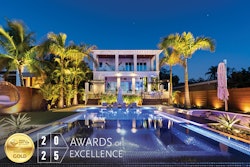
 Frank Wall, president of Frank Wall Enterprises
Frank Wall, president of Frank Wall Enterprises
We talk about the liner all the time, but what about the structures that support it? A 30,000-gallon pool presses down on its floor with a force of a quarter million pounds. If Isaac Newton is right, that pool floor has to push up with an equal and opposite quarter million pounds of support, holding the thin liner fast in the balance. So what do successful builders use underneath the vinyl?
Depends on the builder, says Frank Wall, 50-year veteran of the industry and founder of Frank Wall Enterprises. "There are many different opinions on floors. For myself, I use vermiculite mixed with Portland cement, troweled into the bottom of the pool."
With so much force applied across the liner's 20 or 28 mil cross-section, roughness along the pool floor can be a problem. Imagine the vinyl pressed between two large forces: Anything sharp or abrasive in the surface of the floor can become a liner hole waiting to happen. Dan Lenz, vice president of All Seasons Pools & Spas
Dan Lenz, vice president of All Seasons Pools & Spas
RELATED: Package Pool Installation Pointers
Reducing that friction is worth the extra expense of adding vermiculite, Wall adds. "Yes, vermiculite costs more to use, but it's the least abrasive floor you can put in the pool, and it can extend the life of the liner."
"But the way you use vermiculite? It's all preference," he adds. "I know a builder in New Jersey that buys vermiculite in bags and mixes it with Portland cement and mason sand. He says the sand helps firm that surface up when they trowel it in, and allows him to trowel a flatter, smoother surface.
"Everybody has their own ways of doing it, and for their own reasons. I think the guys who really are doing numbers — the cookie cutter builders, they're trying to get in there the fastest and least expensive way they possibly can — they're going to do a concrete grout bottom poured out of a truck."
PRE-MIX OR MIX YOUR OWN
Unlike Wall's friend in New Jersey who uses his own blend, at All Seasons Pools & Spas in suburban Chicago, they just buy the pre-mixed stuff. "Our preference is Pool Krete, which is a branded vermiculite and Portland Cement mix that needs to be prepared using specific equipment," says Dan Lenz, vice president.
The company uses it because it's softer and easier on the pool liner, so it avoids potential problems during and after installation. And any vermiculite mix product is more forgiving of a freeze-and-thaw climate versus concrete, which can crack in those conditions.
Lenz cautions there is some skill involved in using the product. "You can't push too hard, or you end up with trowel marks that could be seen under the liner. The finishing is more of an art. So if builders don't have that skill set in their crew, concrete is a better floor option as the concrete truck just comes in and pours, and you don't need as much skill to finish the floor."
Both builders are quick to point out that when it comes to package pool floors, there are as many opinions as there are pool companies, and differences are influenced by region, climate, required skill set and costs.
RELATED: The Evolution of Package-Pool Marketing
And while concrete and vermiculite are very common, Wall says, "You do see some sand bottoms, too, more in aboveground pools than inground pools, for cost reasons. If you use sand, you always want to use mason sand, not concrete sand. Mason sand is screened, so it's very consistent in size, where concrete sand has a lot of sharp pieces of sand and little rocks — it's not necessarily designed for a nice finish.
"If somebody uses concrete sand for the bottom of a pool, they're going to get a lot of little rocks in their mix. And for some reason, this rock tends to work its way up to the top surface of that sand. And then it can actually work its way into the vinyl material, creating pinholes in the liner."
 It takes some skill to get a great finish with no trowel marks. In this case, an employee of All Seasons Pools smooths out a pool floor using Pool Krete.
It takes some skill to get a great finish with no trowel marks. In this case, an employee of All Seasons Pools smooths out a pool floor using Pool Krete.
CORNERS
Just as crucial in the pool support mission are the walls, and especially the corners. When you think about it, if you're putting a liner on any container, the corners are going to be the most challenging part. And so they are in vinyl package pools.
Aesthetically, a tight 90-degree angle in the corner probably looks the best — sharp and tidy — and that's how builders used to make them, with a little 6-inch radius. It looked good, but it was hard on the vinyl.
"You can imagine trying to take a plastic bag and push it up into a 90-degree corner and get it to stay there," says Wall, who remembers building such pools. "It's gonna bow out. It's not going to fit that corner real tight. Especially as the liner aged, the liner itself would start deteriorating and shrinking, and it would start pulling out from that corner, kind of creating a tight drum effect. And now you're developing an air pocket between the liner and the wall. And if that corner is in the sun all day, that air pocket starts heating up, getting hotter and hotter. And that starts speeding up the breakdown of the plastics in the liner, and starts shrinking it more, and pretty soon it just splits right there down to the waterline."
In response to that problem, many builders have moved away from 6-inch corners, and started doing 2-foot radius corners, using a smooth curve that the liner can rest against. "It's our No. 1 trick of the trade when it comes to building package pools to ensure you get the most life out of the liner and make it easy for your crew to install quickly and without complications," Lenz says. "Now we do all our rectangle pools with a 2-foot radius corner. It helps to know we are installing a liner that will not fail prematurely because of potential stress on the corners of the liner, nor will we get calls about the liner slipping out of the track."
STEEL AND POLYMER
Another helpful practice for building package pools is using wall foam on steel wall panels, Lenz says. "There are so many different soil types and water tables, there will invariably be steel wall package pools that will rust and potentially fail from rusting. So many builders apply wall foam to the steel wall as a preventative measure to preserve the steel and also to protect the vinyl liner by giving it a cushioned wall surface on which to sit. It's particularly common practice when replacing a pool liner, but many builders also do this on their new package pool construction."
RELATED: Package Pools in the Mix
Because of its upper Midwestern climate, All Seasons now uses polymer wall package pools instead of steel. Cost used to be a factor driving them toward steel, Lenz says, but due to the increase in steel prices, the polymer and steel are now very comparable in price. "Even with the polymer package pools, and even when adding an automatic pool cover, we still use the 2-foot radius corner," he says. "And yes, we have a lot of package pools on which we install automatic pool covers.
Some builders think you have to have a 90-degree or square corner in order to put an auto cover on the pool. But in fact you don't, because several manufacturers offer a solution that goes on top of the package pool walls. It's made specifically for this situation — it essentially creates a square deck opening for the cover. We normally put brick or stone coping around the perimeter of the pool, so you can't even see that the liner below the auto cover is a 2-foot radius. That way we ensure the liner will go in faster and easier for our installers, without any issues, and the liner will last longer for the client — and of course, we can still sell and install an auto cover on the pool, which is becoming a popular option."
This article first appeared in the April 2021 issue of AQUA Magazine — the top resource for retailers, builders and service pros in the pool and spa industry. Subscriptions to the print magazine are free to all industry professionals. Click here to subscribe.












































